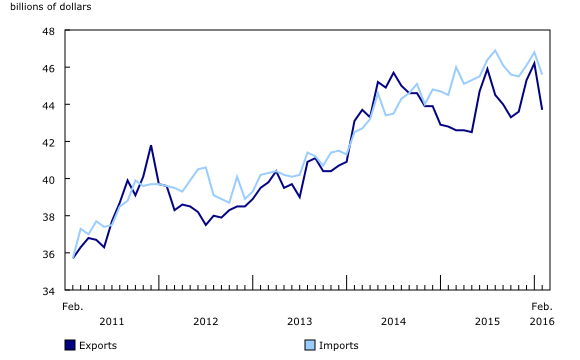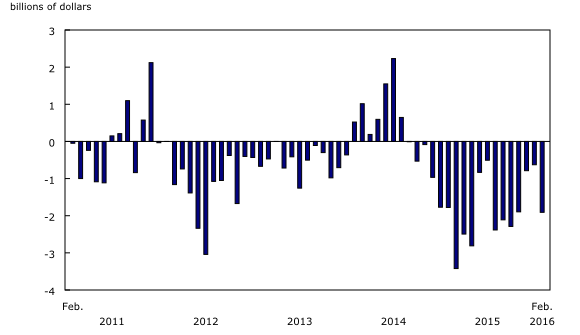Canadian international merchandise trade, February 2016
Archived Content
Information identified as archived is provided for reference, research or recordkeeping purposes. It is not subject to the Government of Canada Web Standards and has not been altered or updated since it was archived. Please "contact us" to request a format other than those available.
Released: 2016-04-05
Canada's exports fell 5.4% to $43.7 billion in February, after reaching a record high in January. Export prices decreased 3.2% and volumes were down 2.2%. Imports declined 2.6% to $45.6 billion, as prices were down 1.4% and volumes decreased 1.2%. Consequently, Canada's merchandise trade deficit with the world widened from $628 million in January to $1.9 billion in February.
Trade with the United States declines
Exports to the United States fell 5.6% to $33.1 billion in February and imports were down 2.7% to $30.5 billion. As a result, Canada's trade surplus with the United States narrowed from $3.8 billion in January to $2.7 billion in February.
Exports to countries other than the United States declined 4.8% to $10.5 billion. There were lower exports to Italy (-34.5%) and Hong Kong (-41.1%). Imports from countries other than the United States decreased 2.4% to $15.1 billion. Countries other than Canada's principal trading partners were the main contributors to the decrease. As a result, Canada's trade deficit with countries other than the United States widened from $4.4 billion in January to $4.6 billion in February.
Consumer goods and energy products lead decrease in exports
Total exports fell 5.4% to $43.7 billion in February. The main contributors to the decline were consumer goods, energy products, and motor vehicles and parts. These decreases were partially offset by higher exports of aircraft and other transportation equipment and parts. Exports excluding energy products were down 4.2%. Year over year, total exports increased 2.1%.
After reaching a record high in January, exports of consumer goods declined 14.3% to $6.2 billion in February. Exports of miscellaneous goods and supplies decreased $466 million to $775 million, following a $433 million increase in January. The articles of precious metals commodity group was the main contributor to both the increase in January and decrease in February. There were also lower exports of pharmaceutical and medicinal products, down 17.3% to $1.2 billion. Other food products fell 10.4% to $1.2 billion, mainly on lower exports of lentils. Overall, volumes fell 12.5% and prices were down 2.1%.
Exports of energy products decreased 14.4% to $4.9 billion, the eighth consecutive monthly decline. Prices for the section fell 10.9% and volumes were down 4.0%. There were lower exports of crude oil and crude bitumen, down 15.6% to $3.2 billion. Exports of refined petroleum energy products declined 15.1% to $566 million.
Following three consecutive monthly increases, exports of motor vehicles and parts decreased 4.4% to $8.7 billion in February. There were lower exports of passenger cars and light trucks (-4.0%) and motor vehicle engines and motor vehicle parts (-7.6%). For the section as a whole, prices declined 3.2% and volumes were down 1.3%.
Partially offsetting these declines, exports of aircraft and other transportation equipment and parts rose 25.2% to $1.9 billion. Aircraft exports increased $402 million to $683 million in February.
Widespread declines in imports
Total imports decreased 2.6% to $45.6 billion in February. There were lower imports in 9 of 11 sections, led by energy products. However, year over year, total imports increased 2.3%.
Imports of energy products fell 29.7% to $1.4 billion, the lowest import value since September 2003. Volumes decreased 21.2% and prices were down 10.8%. The main contributor to the decline in imports was crude oil and crude bitumen, down 45.7% to $550 million. Declining imports have coincided with eastern refineries increasingly sourcing crude oil domestically. In addition, imports of refined petroleum energy products decreased 18.7% to $549 million.
Following four consecutive monthly increases, imports of motor vehicles and parts were down 2.7% to $8.8 billion in February. Imports of motor vehicle engines and motor vehicle parts declined 4.0% to $4.0 billion. Overall, volumes were down 1.4% and prices declined 1.3%.
Imports of metal and non-metallic mineral products decreased 4.8% to $3.7 billion. Unwrought iron, steel and ferro-alloys, and basic and semi-finished ferrous metal products declined 9.6% to $856 million. For the section as a whole, volumes decreased 2.9% and prices fell 2.0%.
Imports of basic and industrial chemical, plastic and rubber products were down 3.4% to $3.7 billion on lower prices. Widespread declines in the section were led by lower imports of plastic resins, down 5.0% to $642 million.
Real trade declines
In real (or volume) terms, exports decreased 2.2% in February, led by consumer goods and energy products. At the same time, import volumes were down 1.2%, mainly on lower imports of energy products. Consequently, Canada's trade surplus in real terms narrowed from $2.9 billion in January to $2.4 billion in February. Year over year, real exports rose 7.8% in February, while imports declined 0.3%.
Revisions to January imports and exports
Revisions reflect initial estimates being updated or replaced with administrative and survey data as they became available, as well as amendments made for late documentation of high-value transactions. Imports in January, originally reported as $46.7 billion in last month's release, were revised to $46.8 billion with the current month's release. Exports, originally reported as $46.0 billion in last month's release, were revised to $46.2 billion.
Note to readers
Merchandise trade is one component of Canada's international balance of payments (BOP), which also includes trade in services, investment income, current transfers, and capital and financial flows.
International trade data by commodity are available on both a BOP and a customs basis. International trade data by country are available on a customs basis for all countries and on a BOP basis for Canada's 27 principal trading partners (PTPs). The list of PTPs is based on their annual share of total merchandise trade—imports and exports—with Canada in 2012. BOP data are derived from customs data by making adjustments for factors such as valuation, coverage, timing and residency. These adjustments are made to conform to the concepts and definitions of the Canadian System of National Accounts.
For a BOP versus customs based data conceptual analysis, see "Balance of Payments trade in goods at Statistics Canada: Expanding geographic detail to 27 principal trading partners."
Data in this release are on a BOP basis, seasonally adjusted and in current dollars. Constant dollars are calculated using the Laspeyres volume formula (2007=100).
For information on seasonal adjustment, see Seasonally adjusted data – Frequently asked questions.
Revisions
In general, merchandise trade data are revised on an ongoing basis for each month of the current year. Current year revisions are reflected in both the customs and BOP based data.
The previous year's customs data are revised with the release of the January and February reference months as well as on a quarterly basis. The previous two years of customs based data are revised annually and revisions are released in February with the December reference month.
The previous year's BOP based data are revised with the release of the January, February, March and April reference months. To remain consistent with the Canadian system of macroeconomic accounts, revisions to BOP based data for previous years are released annually in December with the October reference month.
Factors influencing revisions include late receipt of import and export documentation, incorrect information on customs forms, replacement of estimates produced for the energy section with actual figures, changes in classification of merchandise based on more current information, and changes to seasonal adjustment factors.
For information on data revisions for crude oil and natural gas, see "Revisions to trade data for crude oil and natural gas."
Revised data are available in the appropriate CANSIM tables.
Real-time CANSIM tables
Real-time CANSIM table 228-8059 will be updated on April 14. For more information, consult the document Real-time CANSIM tables.
Next release
Data on Canadian international merchandise trade for March will be released on May 4.
Annual review of international merchandise trade
An annual review of international merchandise trade in 2015 will be released in The Daily on April 6.
Products
Customs based data are now available in the Canadian International Merchandise Trade Database (65F0013X). From the Browse by key resource module of our website, choose Publications.
The February 2016 issue of Canadian International Merchandise Trade, Vol. 70, no. 2 (65-001-X), is also available from the Browse by key resource module of our website, under Publications.
Contact information
For more information, contact us (toll-free 1-800-263-1136; 514-283-8300; STATCAN.infostats-infostats.STATCAN@canada.ca).
To enquire about the concepts, methods or data quality of this release, contact Nita Boushey (613-404-4965; nita.boushey@canada.ca), International Accounts and Trade Division.
- Date modified:




